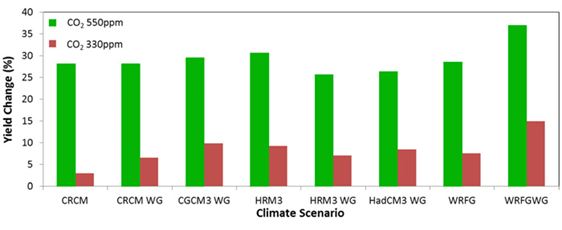From CO2Science: Introducing their study of the oft-predicted effects of likely future increases in the atmosphere’s CO2 concentration and their projected impacts on Canadian agriculture, Qian et al. (2016) begin by noting that “the impact of climate change on crop production is one of the most important issues that society faces, as food security becomes a major concern with a growing global population,” and by more specifically noting that “fluctuations in Canadian production due to weather can have a significant impact on the world wheat supply,” which they remind us is a matter of considerable “significance to the national and international community.”
Paper reviewed: Qian, B., De Jong, R., Huffman, T., Wang, H. and Yang, J. 2016. Projecting yield changes of spring wheat under future climate scenarios on the Canadian prairies. Theoretical and Applied Climatology 123: 651-669.
In responding to this situation and how it might possibly change in future decades, the four Canadian scientists describe how they “employed climate scenarios from the state-of-the-art Regional Climate Models of the North American Regional Climate Change Assessment Program (NARCCAP), along with climate scenarios generated by a stochastic weather generator based on climate change simulations performed by their driving global climate models, to drive the CERES-Wheat model ... to project changes in spring wheat yield on the Canadian Prairies,” for the years 2041-2070 in comparison to the baseline period of 1971-2000.
This work revealed, as Qian et al. report, that “the projected changes showed an average increase ranging from 26 to 37% of the baseline yield when the effects of the elevated CO2 concentration were simulated.” And thus it would appear that the prairies of Canada have the ability to produce even more spring wheat than they do currently, even if -- and especially if -- the atmosphere’s CO2 concentration and temperature would rise as predicted by the world’s climate alarmists.

Figure 1: Projected spring wheat yield change with (green bars) and without (red bars) CO2 effects for the period 2041–2070 (relative to 1971–2000 means) averaged from 11 locations across the Canadian Prairies under eight climate scenarios. Adapted from Qian et al. (2016).



Yeah canada! Saving the world with a little help from two friends; co2 and warmth. The future looks bright!
Climate change witch doctors sound like Jeane Dixon, who could predict any great event on earth the day after it happened.